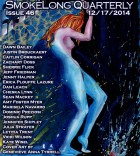Your story uses an interesting mixture of surreal imagery and surreal language. What I mean by that: we see these characters put dolphins into a suitcase with a ton of other things that wouldn’t traditionally fit into a suitcase. This surreal image is paired up with this sort of description, “‘I seem to have put down roots.’ With this he can’t argue. Sturdy legs planted, she is steady as a tree, like something out of a Greek myth.” The description doesn’t describe actual roots; it just describes her in terms of trees and mythical things. At this point in the story, you have already done so much to get the reader able to accept magical things, so why no roots? Or, better yet, is there a difference between language and image?
The image here is straight from a film we were shown too many times in middle and high school, one of those “All About Greek Mythology” primers. It’s from a scene depicting Daphne’s pursuit by Apollo, and just as she’s about to be overtaken, she’s transformed into a laurel tree: legs planted in the earth, arms raised as branches. And, since you asked about language, “plant[ed]” also picks up on the image of roots and, here, literal connections to the earth and thus the place and time one inhabits.
From Steven Millhauser’s The Barnum Museum to George Saunders’ Civilwarland in Bad Decline to Karen Russell’s Swamplandia!, it seems like amusement parks and tourist attractions have been inspiring stories for a while now. What is it about these places that draws storytellers to them? Also, what is your favorite amusement park?
Maybe it’s that amusement parks and tourist attractions are three-dimensional, physical realizations of the “unreal” worlds that writers can manage only on the page. Plus, they come ready made with components of story: motley collections of characters, fertile settings. I’m not a fan of amusement parks, but I like those “World’s Largest Ball of String” attractions that show up at roadsides. South of the Border on I-95 in South Carolina is a good one, along with the giant dinosaurs outside the Wheel Inn on I-10 in California.
This story has a real “end of an era” sense to it. Not only has the business gone under, but the relationship of the people who built the business ends as well. I found it really interesting that their relationship seemed dependent on place and that the man in the story hasn’t “put down roots.” You can talk about that if you want, or you could tell us your best breakup story.
There is this notion of men relating differently to place than women do, of being able to pick up and go with relative ease. But look at it from another angle, as an inability (or unwillingness) to appreciate the importance of inhabiting a place and the caretaking responsibilities that come with it. Physical disconnectedness begets spiritual disconnectedness—that’s the breakup story. The connection severed, place is a fungible commodity, something to trade on or profit from, to impose dominion on rather than to steward—which I’ll submit, at admitted risk of oversimplification, has helped bring about this era of dwindling resources, dwindling biological diversity, and perhaps dwindling habitability. But as long as we have our possessions to drag around with us . . . .
Your story involves people packing their lives into suitcases and still having to leave things behind. If you had a suitcase that could fit any five things that you’ve had to leave behind, what things would you pick and why?
If there’s anything I had to leave behind, I probably didn’t need it enough to bring it.
You have two long lists in your story, which, given the length of the piece, is a bold choice. In an interview with the Paris Review, William Gass had this to say about lists: “I love lists. They begin with no form at all . . . often, anyway. A list of names is very challenging. There is one right order, and the problem is to find it.” What draws you to lists and how do you choose to arrange the items?
Cataloging is an easy way of conveying lots of illustrative and explanatory information in shorthand. It’s obviously very useful, practically speaking, in composing stories of modest length, but you’re right—you have to be careful not to over-rely on it. As for Gass, he was correct regarding the challenge of finding the right order; correctly arranging the items in these lists was the larger part of the work on this piece, involving decisions about rhythm, words, colors, and even the logical progression as dictated by size or animate versus inanimate. But, I knew just what I wanted to include, since pretty much all of these things were to be found at the real place on which this story is based, including, alas, the camel.



 The core workshop of SmokeLong Fitness is all in writing, so you can take part from anywhere at anytime. We are excited about creating a supportive, consistent and structured environment for flash writers to work on their craft in a community. We are thrilled and proud to say that our workshop participants have won, placed, or been listed in every major flash competition. Community works.
The core workshop of SmokeLong Fitness is all in writing, so you can take part from anywhere at anytime. We are excited about creating a supportive, consistent and structured environment for flash writers to work on their craft in a community. We are thrilled and proud to say that our workshop participants have won, placed, or been listed in every major flash competition. Community works.